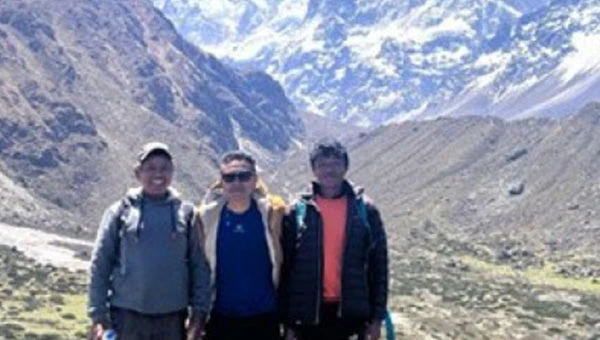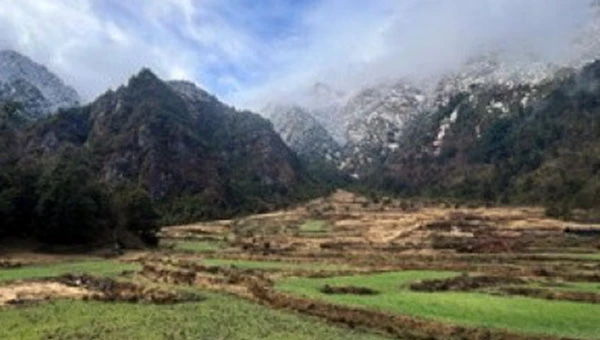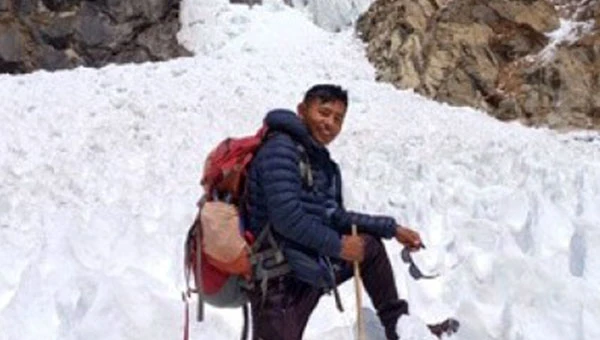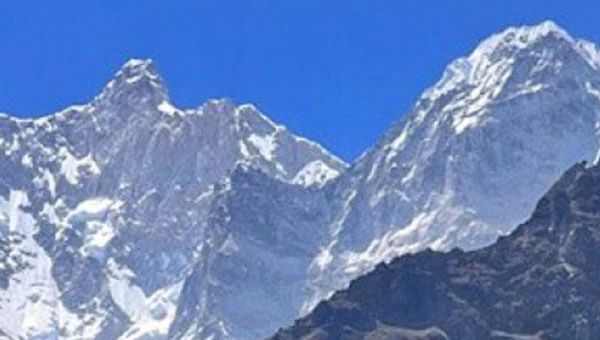Pristine Himalayan Wonders: Top Highlights of the Kanchenjunga Trekking
Besides its difficulty level, you might wonder why Kanchenjunga Trekking’s Popularity is rapidly growing these days, especially among trekkers looking to savor the charm of raw nature, far from the hustle and bustle of modernized cities.
Let’s discuss the top attractions of Kanchenjunga treks, which make it one of Nepal’s most isolated yet rewarding journeys.
Kanchenjunga Base Camps (North-Pangpema and South-Oktang)
Kanchenjunga South/Oktang (4730 m) and North/Pangpema (5143 m) Base Camps, the foothills of Mt. Kanchenjunga, the 3rd highest peak on our planet, are magnificent vantage points for basking in the splendor of the Kanchenjunga massif and other peaks such as Ramtang Peak, Tent Peak, Yalung Kang, Jannu, Kabru, etc., very closely.
Have a deep feeling of accomplishment as you reach the base camps, decorated with colorful Buddhist prayer flags, following the footsteps of legendary mountaineers. The peaceful environment allows you to find satisfaction on inner inside. Forgetting the struggles you make on challenging trekking trails with steep ascents and technical descents, you enjoy the moment because of the stunning Himalayan diversity.
While proceeding to these higher elevations, the landscape becomes narrow, and the oxygen level lowers, requiring proper acclimatization and preparation with the right trekking equipment at several points. Traversing remote and beautiful settlements like Gyabla, Ghunsa, and Khambachen, navigate more rugged terrain with glimpses of glaciers such as Yalung, Ramtang, Kanchenjunga, and Jannu.
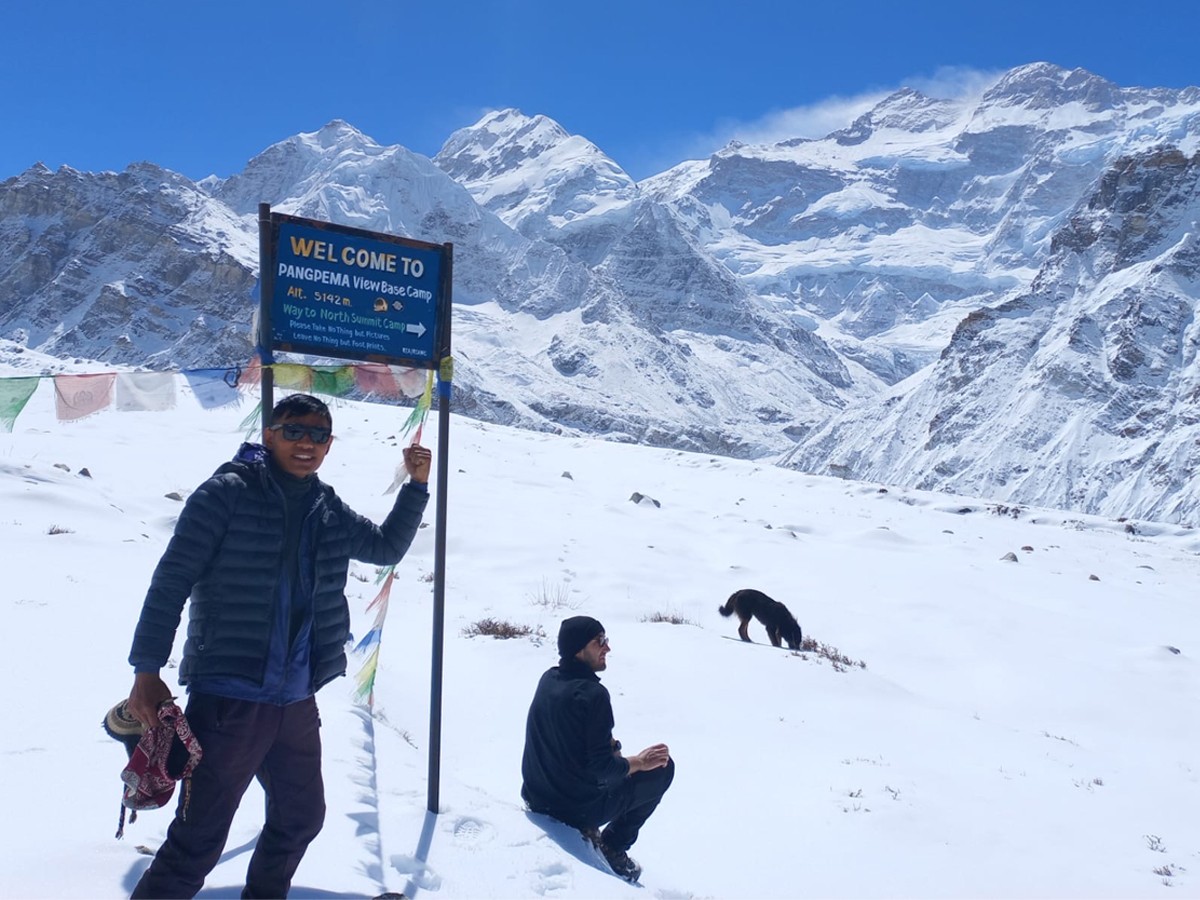
Kanchenjunga North Vs South Base Camp
The Kanchenjunga North Base Camp Trek takes you higher than the South Base Camp. Trekkers are often in a dilemma while selecting the route for the best experience, although both trekking trails offer challenges and rewards while passing through diverse landscapes. Since the North/Pangpema path takes you to a higher elevation landmark through more rugged terrain compared to Oktang Base camp, it is more appropriate for seasoned hikers.
An adventurer with an average fitness level can make it to the South Base of Mt. Kanchenjunga (8586m) with the proper preparation. Neither destination will disappoint you, since these are the most fantastic highlights of the Kanchenjunga trekking.
Kanchenjunga Conservation Area and Wildlife
One of the reasons for trekking in Kanchenjunga is hiking through the Kanchenjunga Conservation Area, a home to a wide range of rare animals and vegetation. In March 1998, the Nepal Government established the portions of the Kanchenjunga region as a conservation Area, named after Mt. Kanchenjunga. Covering an area of 2035 square kilometers, the Kanchenjunga Conservation Area protects fragile biodiversity.
Beginning hiking from either Sekathum or Taplejung, take the Kanchenjunga Trekking’s advantages while walking through the sections of the preserved areas, with a glimpse of the endangered wildlife such as snow leopards, Himalayan Tahr, red pandas, Himalayan black bears, etc. Those who are interested in birding can see various species of birds, including lophophorus, Satyr tragopan, golden-breasted fulvetta, etc, through binoculars and, with the support of a professional field guide, capture birds’ activities in their natural habitats as you hike through dense forests and wetlands.
As you ascend to the higher elevations, you find changes in landscapes from lush subtropical forests to high pasturelands, glacial moraines, and more rugged terrains. At every step on trails alongside lush forests of rhododendrons, maples, oaks, and pines, you can enjoy the beauty of unique flora and fauna and dramatic mountains.
Remote, Traditional Settlements and Cultural Immersion in Kanchenjunga
Among the best Kanchenjunga Facts, the hidden firsthand cultures influenced by Tibetan Buddhism are one, contributing to captivating travelers. As you cross quaint settlements such as Sekathum, Amjilosha, Gyabla, Ghunsa, Khambachen, Cheram, Torongding, etc., explore historically and religiously significant ancient monasteries and gompas where you can see small chortens, mani walls, prayer wheels, and prayer flags.
Spiritual satisfaction makes the Kanchenjunga trek worthwhile, together with the raw charm of the stunning Kanchenjunga region. In monasteries, participate in morning prayer and chanting as monks and nuns. Learn the living way of locals, who have a deep connection to towering peaks and the region, serving trekkers with warm hospitality and food in such remote areas.
However, adventurers find the Kanchenjunga treks enjoyable while exploring quaint villages where different ethnic groups like Rai, Limbu, and Sherpa stay, serving trekkers. They welcome and bid farewell with a delightful face, organizing the cultural programmes with dances and folk music in traditional costumes.
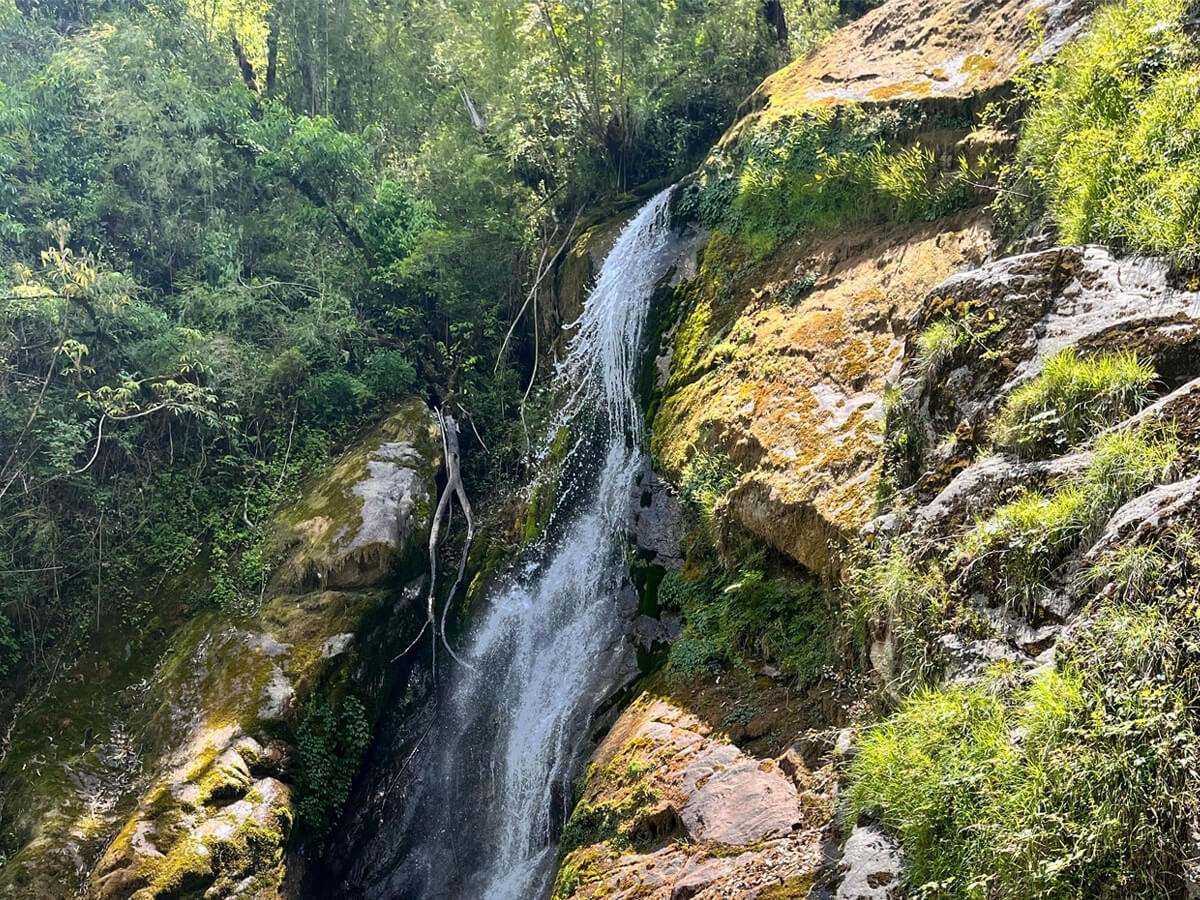
High Mountain Passes and the Kanchenjunga region’s Breathtaking Scenery
Kanchenjunga Trekking is often considered a strenuous journey since you have to traverse challenging terrain, including landslide-prone areas and icy, snowy terrain, with narrow and difficult ascents and descents. One of the most demanding as well as rewarding sections of the journey is passing high-elevation alpine passes such as Sele La (4480 m), Mirgin La (4645 m), and Sinion La (4646 m), which provide panoramic vistas of mountains and awe-inspiring scenery.
Standing at a mountainous altitude above 4,500 meters may lead to high-altitude sickness as the air becomes thinner. Moreover, the environment also dramatically changes from dense forests of rhododendrons into high pasturelands and rough terrain. Although you need extra stamina for crossing these passes, you forget your leg’s pain when the golden rays of sunrise or sunset create a stunning environment, forcing you to take pictures.
Therefore, trekking in Kanchenjunga is not only an ordinary hiking adventure since it tests your physical endurance and lets you feel the relaxation in the silence, offering sounds of bird chirping, tree rustling, and roaring rivers. Does not matter whether you are a novice or seasoned photographer; the Kanchenjunga provides a wonderful backdrop as it is itself a piece of paradise or every trekker’s dreamland.
Short Excursion to Jannu Himal Base Camp
Mt. Jannu/Kumbhakarna (7,711 m) is nestled to the west of Mt. Kanchenjunga and is generally known as a divine summit since it is revered by the Limbu. Jannu’s name is “Phoktanglungma” in the Limbu language, which means “mountain with shoulders,” as Phoktang refers to “shoulder” and lungma means “mountain”.
If you pause at Khambachen for acclimatizing, you can go on a side trip to Jannu Himal (Kumbharkarn) Base Camp, as it is 6-7 kilometers away from Khambachen. The path to the base camp is rough and strenuous. However, you can see spectacular vistas of Mt. Jannu and other surrounding peaks.
After hiking for 3 to 3.5 hours alongside Jannu Himal Glacier, you reach Jannu Himal Base Camp at an altitude of 4,700m. Before heading to Lhonak or Pangpema Base Camp, you can experience this short journey for a more joyful journey in the heart of the Kanchenjunga.
What are the things you must know before starting the trip to take Kanchenjunga Trekking’s advantages?
Can’t imagine any Himalayan odyssey in life without preparation due to potential obstacles. Unpredictable weather may bring unexpected circumstances, sometimes forcing hikers to return without completing the trek or choose a difficult alternative way. Therefore, together with Kanchenjunga Trekking’s advantages, you should understand every essential thing that assists during the journey.
We mentioned above the reasons for trekking in Kanchenjunga, and we have provided below some crucial information regarding the trek:
Best Seasons for embarking on the Kanchenjunga Trekking
You must know an ideal time frame of the year to experience the best features of the Kanchenjunga region without more challenges. While hiking during off-season, you can not enjoy it as much as in spring (March-May) and autumn (Sep-Oct). Stable weather with moderate temperatures lets trekkers hike on dry trails and makes it easier to cross any difficult sections due to minimal rainfalls, snowfalls, and storms.
Although high-altitude landmarks of the Kanchenjunga have unpredictable weather and bring sudden climate changes, choose trekking seasons rather than monsoon and winter. As Kanchenjunga trekking takes you to high alpine passes and Kanchenjunga Base Camps, above 4000m and 5000 m, the proper preparation and trekking gear are essential.
Kanchenjunga Cost and Permits
The Kanchenjunga trek price depends on several elements, such as group size, facilities, porter and guide services, permits, accommodation, and food, as well as the length and duration of hiking. However, you can make the journey on a budget, selecting simple teahouses with common meals and reducing several things’ cost as per your economic condition.
Before embarking on the Kanchenjunga trek, you must obtain a TIMS (Trekkers Information Management System), a KCAP (Kanchenjunga Conservation Area Permit), and a KRAP (Kanchenjunga Restricted Area Permit). The Nepalese Government has made these permits mandatory to control overtourism, ensure every trekker’s safety, and develop local economic status.
Kanchenjunga Trek Difficulty and Travel Insurance
The Kanchenjunga trekking difficulty level is fairly demanding, as the region has less well-established trails compared to Annapurna or Everest region treks. While navigating difficult parts along with the Kanchenjunga Trek’s Highlights, you may get injured sometimes, or altitude sickness may make it hard. If you obtain the right travel insurance that covers helicopter evacuation for emergency medical treatments, you do not have to pay extra money out of your pocket.
The insurance allows you to focus on your hiking since it works as a safeguard throughout the journey, since it also covers unforeseen circumstances, including flight delay or cancellation, private property damage, loss, or theft.
Accommodation and Food along the Kanchenjunga trails
Although the Kanchenjunga region has fewer facilitated teahouses along the way, Kanchenjunga Trekking’s Popularity is gradually rising amidst hikers seeking an unexplored trekking paradise and unparalleled encounters. Remember that simple teahouses with common facilities are available in most settlements, providing basic meals.
In lower elevations, more comfortable hotels or lodges offer updated amenities, including a hot shower, an attached bathroom, and Wi-Fi. In addition, enjoy various items of food, such as Nepalese, Tibetan, and Western.
Professional guide and local porter
Solo trekking in Kanchenjunga or any region is not possible anymore due to the matter of trekkers’ safety. At the time of obtaining trekking permits, you need to be accompanied by a government-licensed guide. Seasoned guides with expertise in speaking English and other local languages can share the best Kanchenjunga facts throughout the journey in a nice way.
A guide helps you navigate tough routes, manage logistics, and deal with high-altitude-related problems or situations when trekkers get injured. A porter is not mandatory for trekking in Nepal, but you can enrich the hiking experience by hiring both a porter and a guide.
Porter lets you walk comfortably, offering to pay attention to your exhilarating journey in the wilderness of the Kanchenjunga region rather than on heavy loads. For their contributions to making your bucket-list adventure successful, you can also give a tip from your pocket.

Preparation for the Kanchenjunga trekking
Preparation does not include only packing your backpack, which has important hiking gear, layers, and other things. Choose the best trekking companies and optimal period, as well as start preparing physically and mentally, as the trekking route is difficult and requires strong hikers for prolonged walking from vibrant subtropical vegetation to barren, craggy paths. Kanchenjunga trekking trails are less developed, and there may be limited shops for buying needed things.
Therefore, carry everything that may be essential on the way, avoiding the extra unnecessary loads. Keep a first aid kit with important high-altitude problem-related medications, important paper documents (trekking permits), toiletries, and other things, as you are not going to get very limited teahouses, health posts, etc. in high elevation terrain. Ensure that you have a professional guide and a local guide who can describe the historical places and their cultural heritage.
Without rushing, proceed to the higher elevations with gradual ascents, adapting to the environment. When you feel some symptoms of Acute Mountain Sickness, you should descend to lower elevations to avoid worse conditions.
Symptoms of High Acute Sickness: Headache, dizziness, nausea, loss of appetite, fatigue, difficulty sleeping, shortness of breath, swelling of face, hands, or feet, confusion, etc.
How does the Nepal Adventure Team’s Itinerary introduce the Highlights of the Kanchenjunga Trekking?
Nepal Adventure Team has different packages for the Kanchenjunga region, including shorter and longer versions. However, the journey usually begins with a guided sightseeing tour in Kathmandu and a drive or flight to Bhadrapur Jhapa. Again, a short, thrilling road ride takes you to Phikkal, a stunning place of large and green tea gardens. From here, another private or local vehicle leads you towards Taplejung, Sekathum, or Khebang based on the selected route.
If you choose the Kanchenjunga North Base Camp Trek, your hiking starts from Sekathum and continues via Amjilosa and Gyabla to reach Ghunsa for acclimatization. Exploring Ghunsa, head to Khambachen and go on a side trip to Jannu Himal Base Camp, If you have a leisure period or you love to stretch your legs more. The next day, head to Lhonak, a wonderful settlement, before getting introduced to one of the most anticipated Kanchenjunga trek’s highlights, the Pangpema/Kanchenjunga North Base Camp, which adds more joy to the trip.
Retracing the same way, get back to Sekathum through Lhonak, Khambachen, Ghunsa, and Amjilosha with mostly descending trails. Afterward, drive to Taplejung, Phikkal, and Bhadrapur Airport, Jhapa for flying back to Kathmandu. In this way, the Kanchenjunga trekking presents you nature blessings with gradual ascents,permitting adequate time for acclimatization.
Our every itinerary is customizable since we prioritize every trekker. As described above, other itineraries will offer you the chance to enjoy the Kanchenjunga Trekking’s advantages. You can understand more by reading packages like
Short Kanchenjunga Base Camp Trek allows you to reach both base camps within 19 days whereas Classic Kanchenjunga Circuit Trek offers more days for learning about the Kanchenjunga region deeply. Therefore, every schedule of the Nepal Adventure Team attempts to give you a unique experience, making it once-in-a-lifetime.
Conclusion
To sum up, it's your preference to choose the best Kanchenjunga itinerary to know the best Kanchenjunga facts. Whether you choose the Classic Kanchenjunga Circuit or the Kanchenjunga North/South Base Camp route, you can relish an unforgettable moment at every step of the trek.
For beginners with a basic fitness level, we can arrange trips to the Annapurna or Langtang region since there are packages such as the Mardi Himal Trek, Langtang Valley Trek, Ghorepani Poonhill Trek, etc. For the Monsoon season Upper Mustang Trek, Narphu Valley Trek, and Dolpo region trekking are the best option for risk bearers. Plan for one of the challenging trekking trails through pristine forests, glaciers, and remote traditional villages of different communities.
For more inquiries, you can contact us on WhatsApp or do email since we are 24 hours available on your service.





